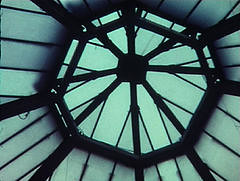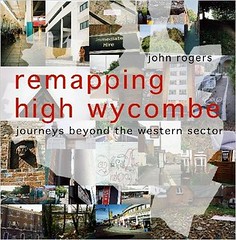Interview in the Bucks Free Press
Author mourns Wycombe's loss of identity
ONCE known as a potential safe haven for Londoners during times of catastrophe, High Wycombe is today facing a catastrophe of its own as the town's identity gradually erodes away, says author John Rogers.
John, who was born in High Wycombe and raised in Wooburn Green, has just published his book, Remapping High Wycombe: Journeys Beyond The Western Sector, which questions the impact of redevelopment on the town itself. The book, and an accompanying DVD, formed part of an 18-month public art project developed by John's sister, Cathy, and was financially supported with grants from Arts Council England.
The impetus for the project, says John, was the announcement of redevelopment plans in the town centre, a mixed-use retail-driven scheme that was initially called Project Phoenix, but which later changed its name to Project Eden and is expected to finish in 2008.
The 35-year-old, who now lives in East London with his wife, Heidi, and two young sons, is keen to point out that both project names suggest "revival", but he believes the opposite is in fact true.
John says: "High Wycombe once had a distinctive identity. It was called "Chairopolis" because it was the centre of the chair-making industry. But its industrial heritage is now slipping away and High Wycombe is like anywhere else.
"People say High Wycombe survived the Luftwaffe, but not the urban planners of the 1960s.
"Cathy and I looked back at the headlines from the 1960s and saw the doom and gloom newspapers spell for so-called "development".
"But those headlines are little different from the ones we see today. We've learnt absolutely nothing. And why? Because the drive behind the development is always the same - money."
John tells me he feared the town would undergo such radical change that in only a few years, his birthplace would become "unrecognisable".
With the help of his sister, he decided to capture High Wycombe, in words and film, before its transformation is complete, as well as rediscover the town's "forgotten history".
John says he also became increasingly interested in psychogeography, or how a place affects people's emotions and behaviour.
"The basic idea we came up with was to look at the way people connect to an area and how this can be disrupted," says John. "In recent months, High Wycombe has been described as "a leading M40 corridor town", because of the new developments in place.
"How is this something we should be aspiring to and how does that affect the people who live there?
"High Wycombe was once known for better things, such as producing two Prime Ministers, the Earl of Shelburne and Disraeli. How many other towns can lay claim to that?"
John adds in his book that he found many other reasons why the people of Wycombe should be proud of their area.
He writes: "Apparently there is a saying that the river Wye gave the town its mills, the mills produced the market and the market gave birth to the town.
"It's where the early translators of the Bible found support, where Engish Civil War took root, where the Quakers plotted their flight to America, the US Air Force based their Cold War communications; and where RAF Strike Command still rests in the hills."
With these thoughts in mind, John tells me he set out to "rediscover" the historical High Wycombe for himself.
He discarded his maps and instead embarked upon a series of walks or "drives", purposeful drifts around the streets of the town that he believed would help him see the town with fresh eyes.
"It was all about seeing past the surface level," says John. "I've travelled a lot in the past, around India and Australia, and I think it's really helped to heighten my senses.
"I can wander around places with innocent eyes and even the most mundane things are fascinating to me."
With his trusty camera by his side, John took pictures of crumbling engravings, vandalised bus shelters, picnic tables scrawled with graffiti, sharp razor-wire fences and ancient stone bridges.
Each has come from a different time and has a different purpose, but, explains John, they all make up the High Wycombe of today, and as such, deserve to be recorded in his book.
"My investigation threw up all kinds of fascinating things I never knew before. I discovered an ancient footpath in Green Street, which stretches back to before the Romans, possibly 5,000 years, maybe earlier.
"There's so many little footpaths everywhere, and who knows where they lead?
"Some seem like they don't go anywhere, but the important thing is that they once did."
John says he is proud of his book, if only because it offers a "snapshot" of the town, preserving it before it changes for good. He now plans to return to High Wycombe in future years and document the town's changes again.
"The main thing is that we found another Wycombe. We found our own town. We ignored the maps and we discovered a town that still has a very strong spirit of place. That can't be taken away, whatever lies ahead."
Remapping High Wycombe: Journeys Beyond The Western Sector is currently available exclusively at www.lulu.com/cryptotopography. For more information, log onto http://remappinghighwycombe.blogspot.com.
1:13pm Friday 8th December 2006
By Francine Wolfisz
Here's an earlier piece in the BFP




0 Comments:
Post a Comment
<< Home